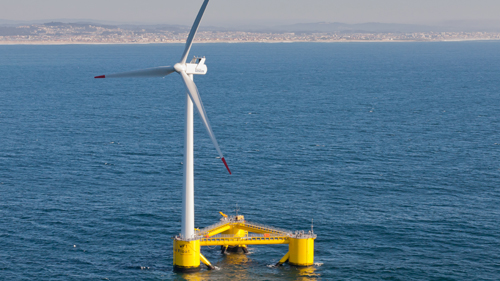The Global Wind Energy Council (GWEC) has launched a Floating Offshore Wind Task Force with key global industry players to accelerate the growth of this fast-moving offshore wind power sector by developing a common view to address barriers to growth and provide best practices.
The Task Force will be Chaired by industry pioneer Henrik Stiesdal, and Vice-Chaired by floating offshore expert and former Deputy CEO of RenewableUK Maf Smith.
As of the end of 2019, there is currently 65.7 MW of floating offshore wind farm capacity installed globally, with up to 19 GW forecasted to be installed by 2030, depending on the speed that cost reduction of wind turbines can take place.
Floating offshore wind energy has the potential to increase offshore wind resource by a factor of ten, and will play an increasingly important role in expediting the energy transition at the necessary rate to maintain a 1.5°C pathway in line with IPCC recommendation.
The Global Wind Energy Council (GWEC) has announced the formation of a Floating Offshore Wind Task Force with participation of key global industry players and associations to drive global growth of floating offshore wind.
Floating offshore wind is a significant market opportunity, and can increase offshore wind resource by tenfold by opening new markets where fixed-bottom offshore wind would not be possible. As of the end of 2019, 65.7 MW of floating offshore wind capacity was installed globally, in the UK, Japan, Portugal, Norway and France.
According to GWEC Market Intelligence forecasts, 6.2 GW of floating offshore wind is likely to be built by 2030 given the current project pipeline. However, this forecast could be increased to up to 19 GW if cost reduction is accelerated.
Henrik Stiesdal, Chair of the Floating Offshore Wind Task Force said: “We are at a turning point for floating offshore wind, with rapid acceleration taking place in markets around the world. To ensure the success of the industry and achieve the cost reduction needed to ramp up deployment of the technology, we need to see coordination amongst the leading market players and share our experiences in the different pioneer markets emerging globally. This Task Force will be an important forum to facilitate this exchange and establish a common voice to provide best practices for the industry when entering new markets to expedite the immense growth potential of this important technology”.
Ben Backwell, CEO at GWEC added: “Offshore wind will be a key driver of the energy transition, with some industry stakeholders calling for over 1,400GW of offshore wind capacity installed by 2050. To reach this goal, expediting the development of floating offshore wind is crucial to deploy turbines in deeper waters and unlock up to ten times more offshore wind resource than is possible with fixed-bottom turbines alone. We are thrilled to have Henrik Stiesdal chairing this important Task Force as a pioneer of the floating offshore sector, and are confident that through his insights and the experience of the other Task Force members, we will be able to address the most urgent barriers for growth of the sector and spur a new era of offshore wind”.
The Floating Offshore Wind Task Force will be chaired by GWEC Global Offshore Wind Ambassador and industry pioneer Henrik Stiesdal, and Vice-Chaired by Maf Smith, floating offshore wind expert and former Deputy CEO of RenewableUK.
Members of the Task Force consist of leading stakeholders in the floating offshore wind sector, including: Equinor, GE Renewable Energy, Iberdrola, Ideol, the Japanese Wind Power Association, MHI Vestas, Ørsted, Principle Power, RenewableUK, Siemens Gamesa Renewable Energy, Shell, Stiesdal, wpd, and The World Bank Group.
The first actions of the Task Force will be to define the priority markets for offshore wind, and engage with the relevant local associations, policymakers and NGOs in the fishing, marine mammals and ports sectors through a sequence of conferences, seminars and workshops to promote and educate stakeholders about the floating offshore sector and to share best practices.


